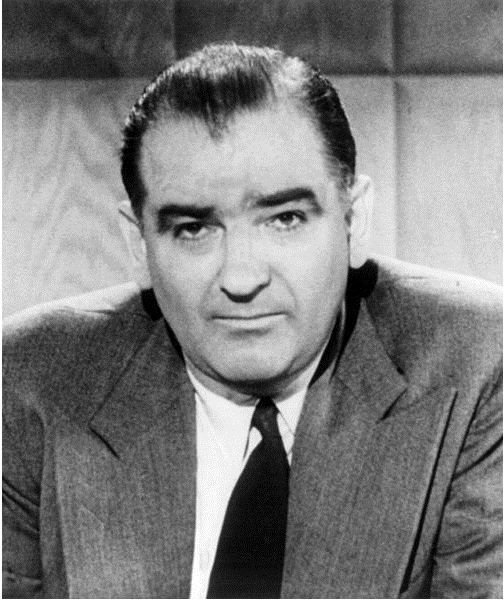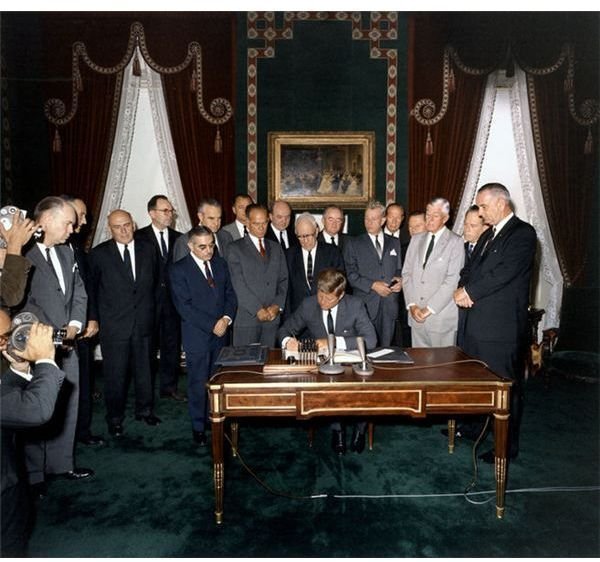Timeline of the Cold War: Important Events of the Era
For many, the strange alliances formed during World War II were a trade-off between threats. The possibility of a fascist world dominated by Hitler and Imperialist Japan was worth the partnership with the USSR. Post-war years would strain this tenuous bond, and the prolonged period of fear and distrust between the divergent systems of capitalism in the West (US, Britain, France, etc) and socialism and communism in the East (USSR and other Communist states) became what is known as the Cold War.
A Cold War is a war of deterrence, one of weapon development and stockpiling in the hope of becoming a threat too ominous for the other side to challenge. Following the Second World War, the United States and the Soviet Union (USSR) became the key players in the Cold War. Important events of this era would include expansion of power, nuclear proliferation, space exploration, espionage and episodes of heightened paranoia on both sides.
Ironically, one of the most important events in the cold war era was an attempt to ensure peace. The Allies of WW II, also known as united nations, formally signed a charter forming the United Nations (UN) on June 26, 1945. The goal of the UN was, and still is, to create a means of securing peace between nations in the future, using military intervention as a final option.
Five years later when this option was used for the first time during the Korean conflict, the toll the Cold War had taken on East-West relations would be apparent in the absence of one of the five permanent member nations of the UN Security Council-the Soviet Union when the vote was taken. Just as in Europe, the Korean peninsula had been split between the allies. North Korea was occupied by the Soviets while Americans remained in South Korea. One year after the US removed its troops, North Korean communist forces invaded South Korea. Permanent members of the UN Security Council had the power to veto any decisions and so the Soviets’ absence allowed military intervention in the Korean War, one of the Cold War’s most important events. In cold war, conflict could clearly heat up.
1946-47
1946
February 9-Stalin delivers a speech to voters in Moscow which blames the two world wars on capitalism, and puts forth the idea the capitalism and communism will never exist in harmony.
February 22-In an 8,000 word message to Washington D.C., American diplomat George Kennan advises “a long-term, patient but firm and vigilant containment of Soviet expansive tendencies.” (Hodgson, pg. 257). Kennan always insisted he meant political and not military actions should be used to achieve containment.
March 5-Winston Churchill gives a speech in Fulton, MO warning the world of the Iron Curtain that existed across the European continent behind which lay the Soviet sphere with an eye on expansion.
1947
March 12-Harry S. Truman outlined a policy of containment in a speech to a joint session of Congress that asked for $400 million in financial and military aid for Greece and Turkey. The speech came following an announcement by Great Britain that it could no longer provide aid to Greece and Turkey; both nations were under pressure to turn to communism. This speech and its message came to be known as the Truman Doctrine.
1948-1949
1948
April -The Marshall Plan: The Economic Cooperation Act of 1948, or the Marshall Plan, provided aid to Europe so that the war ravaged nations could rebuild their agricultural and industrial capacities.
June 1948-May 1949-The Soviets blocked all access to West Berlin when the US, Great Britain, and France combined their separate zones in West Berlin and began to introduce economic reform.
June 1948 – September 1949- Berlin Airlift: The US and Britain operated round-the-clock airlifts of food and medical supplies to West Berlin.
August-Republic of Korea founded in South Korea. The new government proclaimed governance of North and South Korea.
September -Democratic People’s Republic set-up in North Korea. This government also asserted authority over North and South Korea.
1949
Germany is officially divided into the Federal Republic of Germany (West Germany) and the German Democratic Republic (East Germany).
Communist Party comes to power in China.
The Soviet Union detonates its first nuclear bomb.
NATO-North Atlantic Treaty Organization: A military alliance formed by the US, Great Britain, France, Italy, Norway, Portugal, Iceland, Denmark, Canada, Belgium, Luxembourg, and the Netherlands. It has grown to include more nations.
COMECON-Council or Mutual Economic Assistance: A attempt to link the economies of communist nations.
Important Events in the 1950s

The following decade saw a significant growth in paranoia, evidence of the fear and mistrust during the Cold War. Important events sparked by paranoia included civic leaders in the town of Mosinee, WI staging a Soviet occupation. Religious clergy were arrested and the school was ambushed by fake Russian soldiers who burned books and served black bread and potato soup for lunch. Even the local newspaper got involved in the deception.
Paranoia reached its zenith with McCarthyism. Chairman for the Senate subcommittee, Committee on Un-American Activities, Joseph McCarthy created a witch-hunt atmosphere beginning in 1950 when he announced the presence of 207 communists in the State Department. This wasn’t true of course, but it set off a slew of accusations against anyone suspected of ties to communism. Most were false accusations. Labor unions, Hollywood professionals, experts on China and almost anyone who had joined the Communist Party in the US during the 1930s were favorite targets of McCarthy.
The fervor lasted for four years, finally coming to an end in 1954 when Senator McCarthy began hearings into the possibility that the US Army was infiltrated by communists. He had gone too far and was censured by the Senate after being asked by Republican lawyer Joseph Welch on live television, “Have you no sense of decency, sir, at long last?” (Hodgson, pg. 259.) McCarthy died of alcoholism in 1957.
The Fifties decade fell within the Col War era and was also the time of some of the most important events in the Cold War. Truman gave support to the French in their effort to keep control of Vietnam during the early 1950s. This policy would eventually lead to American troops being deployed to fight in the Vietnam War. This was one of the most contentious wars fought by the US and, like the Korean War, was a hot war in the midst of a cold one. A military alliance between the Soviets and Eastern Europe Communist governments known as theWarsaw Pact was formed in 1955, and Sputnik was launched in 1957. Space exploration had become an arena for Cold War tension and competition to play out in. Sports were another Cold War battleground and would remain so throughout the era.
Détente and the End of the Cold War
Joseph Stalin died in 1953 paving the way for the eventual ascension of Nikita Khrushchev who began a period known as a détente, or eased tensions. This period ushered in improved interaction which enabled the signing of the 1968 Nuclear Nonproliferation Treaty, the 1972 Strategic Arms Limitation Treaty SALT I and the Helsinki Accords in 1975. These last promoted better cooperation between Eastern and Western Europe.
There are historians who see the détente as the end of the Cold War despite such incidences as the shooting down of an American U-2 spy plane in 1960, the construction of the Berlin Wall and the Bay of Pigs episode in 1961, and the Cuban Missile Crisis in 1962. Others view détente as a mere break. Either way, open hostility between the super-powers returned in 1979 when the USSR, under Leonid Brezhnev, invaded Afghanistan to suppress an anti-communist movement.
The 1980’s would truly be the beginning of the end of the Cold War. Mikhail Gorbachev became the Soviet leader in 1985 and began the policies of glasnost (openness) and perestroika (restructuring) which reduced the power of the Communist Party. Eastern bloc nations watched and took advantage of this new atmosphere. The Polish government allowed the Solidarity Union, formed in 1980, to act freely and the Communist Party lost its persuasion there. This held true for many Eastern European Communist countries and by the end of the decade most had overthrown their communist regimes in favor of more democratic governments. The overthrow in Czechoslovakia was so tranquil it has been deemed the Velvet Revolution; Romania was not so lucky and its revolution ended with the execution of dictator Nicolae Ceausescu.
Gorbachev and President Reagan removed intermediate nuclear missiles from Europe in 1986 followed by short range and medium range ones the next year. The Soviet Union left Afghanistan in 1989. The same year the Berlin Wall was destroyed and Poland and Hungary became independent states. On October 3, 1990 Germany was unified. Boris Yeltsin was elected President of Russia on May 29, 1990 and the Soviet Union officially dissolved in 1991 bringing an undeniable end to the Cold War.
References
Hodgson, Godfrey, (1998). People’s Century. New York, NY: Time Books.
Nelson, Rebecca, (2004). The Handy History Answer Book. Barnes & Noble Inc.
https://www.pbs.org/wgbh/peoplescentury/index.html
https://www.americanrhetoric.com/speeches/winstonchurchillsinewsofpeace.htm
https://www.history.com/topics/cold-war
Kennedy signing the Limited Nuclear Test Ban Treaty taken Oct 7, 1963. Photo in the public domain via Wikimedia Commons.
